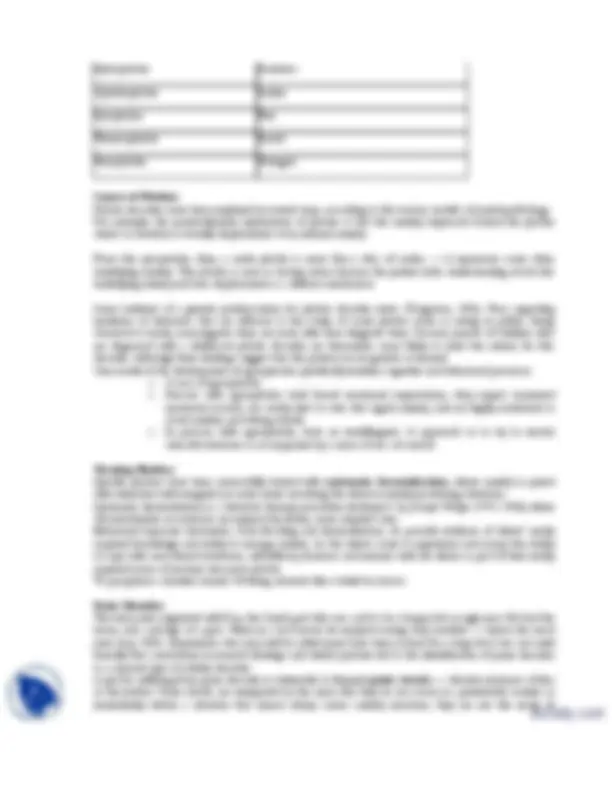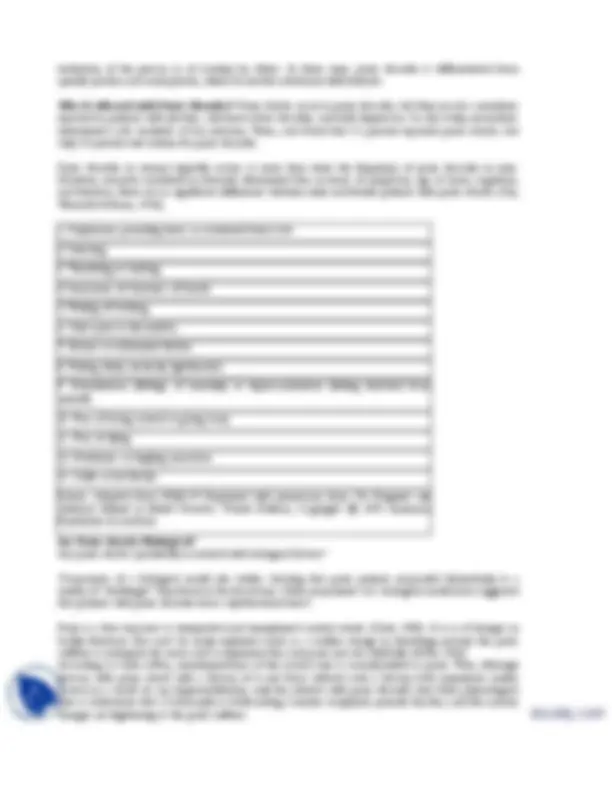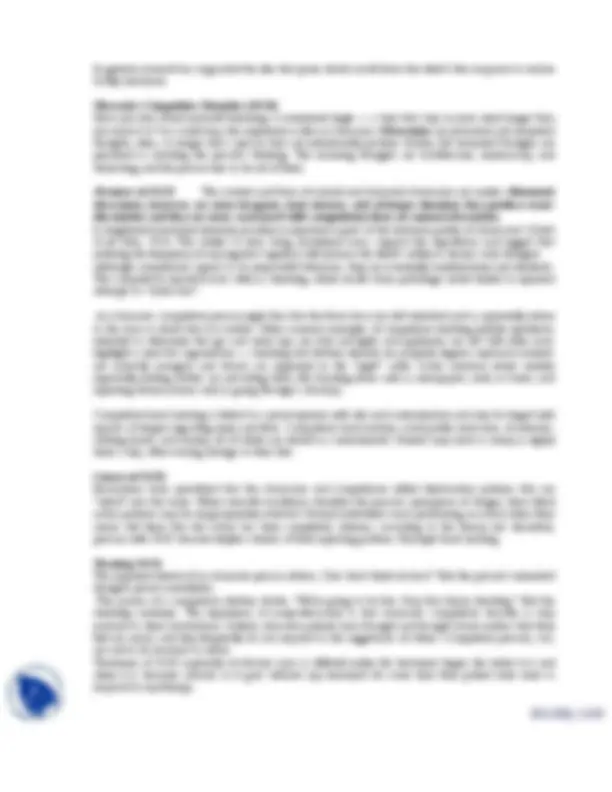





Study with the several resources on Docsity

Earn points by helping other students or get them with a premium plan


Prepare for your exams
Study with the several resources on Docsity

Earn points to download
Earn points by helping other students or get them with a premium plan
Community
Ask the community for help and clear up your study doubts
Discover the best universities in your country according to Docsity users
Free resources
Download our free guides on studying techniques, anxiety management strategies, and thesis advice from Docsity tutors
An overview of different anxiety disorders, focusing on phobias and panic disorder. It discusses symptoms, diagnostic criteria, and treatment methods such as systematic desensitization and behavioral exposure. Phobias include specific and social phobias, and panic disorder is characterized by unexpected panic attacks. The document also touches upon the biological and psychological explanations of these disorders.
Typology: Exercises
1 / 7

This page cannot be seen from the preview
Don't miss anything!




Before GAD can be diagnosed, several criteria must be met. According to DSM-IV, the excessive and unrealistic anxiety and worry must be present for a minimum of six months; impulses must be experienced as difficult to control; and they must be associated with at least three of the following symptoms:
Treating GAD Borkovec and his colleagues (1983) have provided some interesting information about the ability of clients to learn how to manage their worrying. In one study clients reported that worry consumed approximately 50 percent of each day and caused those major problems. During an intervention, the clients participated in a program that included (1) establishing a specified half-hour period (same place, same time) for daily worrying, (2) identifying negative thoughts and task- relevant thoughts, (3) postponing worrying until the allotted time, and (4), at the time assigned for worrying, engaging in intense worry and problem solving. After four weeks, the treated subjects showed a reduction in the percentage of time they spent worrying. Apparently, providing a time and place for worrying (stimulus control) reduces its detrimental effects.
Phobic disorders are tied to specific objects or situations. Phobias are intense, recurrent, and irrational fears that are disproportionate to the actual situation. Claustrophobia, the fear of closed spaces, is a common example of a phobia. Small room or lift etc. Most of us have some discomfort or fear associated with fire, disease, snakes, and being in small and enclosed places. Youngsters have been known to avoid walking near an abandoned “haunted house,” and college students may avoid biology courses because they are uneasy about the blood that is rumored to be a part of the lab work. To a degree, these fears are rational but Phobic reactions are irrational. Phobias involve specifiable fear reactions — Clients with phobias recognize that their fears are excessive and unreasonable, and they work to avoid the phobic stimulus. Symptoms such as headaches, dizziness, stomach pains, and other general physical complaints are often reported in association with phobias. Lack of self-confidence and mild depression may also accompany phobic conditions. Fainting has been reported in phobic exposed to the feared situation or object (such as the sight of blood), but these reports are not as prevalent as once thought.
Some phobias, such as those provoked by small animals, are present in early childhood, but phobic disorders typically begin in adolescence or early adulthood.
lifetime prevalence of 14.2 percent of the population (Eaton, Dryman & Weissman, 1991). Using current diagnostic criteria, and sampling from more than eight thousand people from non- institutional households, Magee and associates (1996) reported lifetime prevalence of 13.3 percent for social phobia, 11.3 percent for specific phobia, and 6.7 percent for agoraphobia.
Specific (Simple) Phobias Specific phobias are pathological (excessive and unrealistic) fears of specific animals, objects, or situations. Common examples include phobias of the needles, elevators, dogs, snakes, storms, blood, dentists, and tightly enclosed spaces although the phobic individual may be reasonably well adjusted when not directly faced by the phobic stimulus, he or she experiences anticipatory anxiety when aware of an impending situation that could force a confrontation with the object of fear. When the phobic individual is actually exposed to the phobic stimulus, there is almost invariably an intense and immediate anxiety response. For example, the person with needle phobia who comes in contact with a needle will report sweating, difficulty breathing, and a racing heart. The phobic stimulus is viewed as powerful indeed, as this example illustrates. In an experiment conducted in the Netherlands. Women with phobias were shown various, slides of phobic stimuli and given very mild shock. The researchers concluded that because phobic stimuli cause such discomfort, they are routinely avoided rather than faced directly and endured.
Social Phobias It refers to being asked to perform before an audience will produce some anxiety in almost all of us. The thought of having nothing to say or of saying something inappropriate causes us to become self-conscious and nervous. These are normal, rational fears. Social phobias, however, involve a persistent fear of being in a social situation in which one is exposed to scrutiny by others and a related fear of acting in a way that will be humiliating or embarrassing. As self-focus increases, so does the anticipation of anxiety (Woody, 1996). Phobic and non-phobic individuals have comparable concerns, but the intensity, extremeness, and irrationality of the reactions of social phobic set them apart from their non-phobic counterparts.
Examples of social phobias include irrational reactions to eating in public places, using public restrooms, or speaking in front of large groups of people. Like the specific phobic, the social phobic experiences marked anxiety when anticipating the phobic situation and therefore usually avoids it. This avoidance interferes with the person’s daily routine and can potentially ruin his or her career.
Agoraphobia The term agoraphobia, which is derived from the Greek word agora, meaning marketplace, was originally used to refer to a pathological fear of open or public places. At present, agoraphobia is considered a fear of being alone or of being in public places where escape is difficult or where help is not readily available in case of a panic attack that the person fears would be overwhelming. The agoraphobic might experience intense fear in shopping malls during the holidays, in crowds at concerts or sports events, and in tunnels, bridges, or in public transport. Agoraphobia also occurs within an interrelated and overlapping cluster of phobias, such as a phobia of cars, buses, planes, and trains. As a result of agoraphobia, the sufferer restricts travel or requires a companion when away from home.
Label Fear
Agoraphobia Open places
Aichmophobia Pointed objects
Algophobia Pain
Arachnophobia Spiders
Astraphobia Storms; thunder and lightning
Claustrophobia Closed spaces; confinement
Hydrophobia Water
evaluation of the person or of scrutiny by others. In these ways, panic disorder is differentiated from specific phobia and social phobia, which do involve situational determinants.
reported in patients with phobias, substance-abuse disorder, and mild depression. In one study, researchers interviewed 1,306 residents of San Antonio, Texas, and found that 5.6 percent reported panic attacks, but only 3.8 percent met criteria for panic disorder.
Panic disorder in women typically occurs at more than twice the frequency of panic disorder in men. However, research conducted in Australia determined that, in terms of symptoms, age of onset, cognition, and duration, there are no significant differences between male and female patients with panic attacks (Oei, Wanstall & Evans, 1990).
Source: Adapted from DSM-1V Reprinted with permission from The Diagnostic and Statistical Manual of Mental Disorders, Fourth Edition, Copyright @ 1994 American Psychiatric Association.
Are Panic Attacks Biological? Are panic attacks specifically associated with biological factors?
Proponents of a biological model cite studies showing that panic patients responded distinctively to a variety of “challenges” they faced in the laboratory. Other proponents of a biological model have suggested that patients with panic disorder have a dysfunctional heart.
Panic is a fear response to unexpected and unexplained somatic events (Clark, 1989). It is as if changes in bodily functions that can’t be easily explained (such as a sudden change in breathing) prompt the panic sufferer to anticipate the worst and to experience fear and panic (see also McNally & Eke, 1996). According to Clark (1986), misinterpretation of the arousal cues is causally linked to panic. Thus, although persons with panic attack with a history of it and those without such a history both experience similar arousal (as a result of, say, hyperventilation), only the subjects with panic disorder view these physiological cues as indications that a catastrophe is forthcoming. Somatic complaints precede the fear, and the somatic
In general, research has supported the idea that panic attacks result from the client’s fear response to certain bodily sensations.
Obsessive-Compulsive Disorder (OCD) Have you ever found yourself humming a commercial jingle — a tune that stays in your mind longer than you want it to? In a small way, this experience is like an obsession. Obsessions are persistent and unwanted thoughts, ideas, or images that a person does not intentionally produce. Rather, the unwanted thoughts are perceived as invading the person’s thinking. The recurring thoughts are troublesome, unnecessary, and distracting, and the person tries to be rid of them.
obsessions, however, are more frequent, more intense, and of longer duration; they produce more discomfort; and they are more associated with compulsions than are normal obsessions. Is heightened emotional intensity possibly an important aspect of the intrusive quality of obsessions? (Clark & de Silva, 1985). The studies to date, using nonclinical cases, support this hypothesis and suggest that reducing the frequency of any negative cognition will increase the client’s ability to dismiss such thoughts. Although compulsions appear to be purposeful behaviors, they are essentially nonfunctional and ritualistic. The compulsion reported most often is checking, which results from pathologic doubt linked to repeated attempts to “make sure”.
An obsessive- compulsive person might fear that the front door was left unlocked and so repeatedly return to the door to check that it is locked. Other common examples of compulsive checking include repetitions intended to determine that gas and water taps are shut and lights and appliances are off. Still other cases highlight a need for organization — checking that kitchen utensils are properly aligned, cupboard contents are correctly arranged, and closets are organized in the “right” order. Some common rituals include repeatedly putting clothes on and taking them off; hoarding items such as newspapers, mail, or boxes; and repeating certain actions such as going through a doorway.
Compulsive hand washing is linked to a preoccupation with dirt and contamination and may be tinged with reports of disgust regarding urine and feces. Compulsive hand washers avoid public restrooms, doorknobs, shaking hands, and money, all of which are viewed as contaminated. Patients may wash as many as eighty times a day, often causing damage to their skin.
Causes of OCD Researchers have speculated that the obsessions and compulsions reflect fixed-action patterns that are “wired” into the brain. When stressful conditions stimulate the person’s perception of danger, these fixed action patterns may be inappropriately activated. Normal individuals cease performing an action when their senses tell them that the action has been completed, whereas, according to the theory just described, persons with OCD become helpless victims of their repeating patterns. Example hand washing.
Treating OCD The impatient friend of an obsessive person advises, “Just don’t think about it.” But the person’s unwanted thoughts persist nonetheless. The spouse of a compulsive checker shouts, “We’re going to be late. Stop that damn checking.” But the checking continues. The experience of nonprofessionals is that obsessive- compulsive disorder is very resistant to direct instructions. Indeed, obsessive patients have thought and thought about matters that they feel are major, and they frequently do not respond to the suggestions of others. Compulsive persons, too, are said to be resistant to advice. Treatment of OCD especially of chronic cases is difficult earlier the treatment begins the better it is and when it is becomes chronic or it goes without any treatment for some time then patient takes time to respond to any therapy.
“Neuroses Are No Longer a Psychological Problem!” If such a headline had appeared in the newspaper, it would have been technically accurate, because, the DSM IV TR system abandoned the use of terms and categories related with neurosis. For example, phobic neurosis is now called specific phobia or social phobia, and obsessive-compulsive neurosis became obsessive- compulsive disorder. Panic and anxiety combine to form different anxiety disorders 1- Generalized Anxiety Disorder (GAD) 2- panic with agoraphobia 3-Specific phobia 4- social phobia 5-Post Traumatic Stress Disorder (PTSD) 6-Obessive Compulsive Disorder (OCD) Anxiety is very hard to study. In humans a sense of uneasiness, looking worried and anxious. The physiological response of anxiety is reflected in increased heart beat and muscle tension. Anxiety is not pleasant; it is some unpleasant thing most commonly observed.